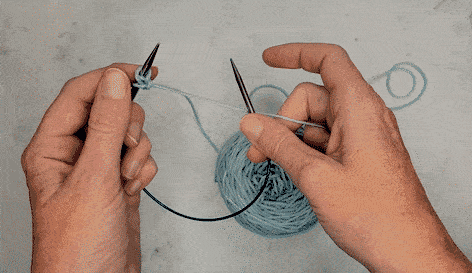The Cable Cast-On was the second CO that I successfully learned when I started knitting, the first being the Knitted Cast-On. It’s a great step for newer knitters to learn after getting the hang of the knitted cast-on, and of knitting itself. The process is similar to the act of knitting; each new stitch is pulled from between the stitches before.
Here’s a video to guide you through the process of how to cast on using the cable cast-on.
The Cable Cast-On, step-by-step
Step 1. Make a slipknot and place it on your left-hand needle. This is your first stitch.
Step 2. Using your right-hand needle, poke the tip into the slipknot as if to knit, wrap the yarn and pull through, as if to knit, and then place the new loop on the left needle. You’ve just created your second stitch.
Step 3. Using your right-hand needle, poke the tip BETWEEN the two stitches on the left-hand needle, wrap the yarn and pull through, as if to knit, and then place the new loop on the left needle. You’ve just created another stitch.
Step 4. Using your right-hand needle, poke the tip BETWEEN the two most recent stitches on the left-hand needle, wrap the yarn and pull through, as if to knit, and then place the new loop on the left needle. You’ve just created another stitch.
Repeat step 4 until you have all of the required stitches for your cast-on.
Poof. Done. That’s it!
About the Cable Cast-On
Though technically classified as having minimal stretch, the cable cast-on is actually great to use for ribbing. Its somewhat sturdy structure prevents excessive stretching or flaring of the ribbing used on hats, sweaters, and socks, to name a few. This being said, it’s important to note that if your average tension is mid-range to tight, you’ll likely need to increase your needle size by one or two for the cast-on edge to comfortably stretch along with the ribbing. If you’re able to control your tension to be somewhat loose as your newly-created stitches are placed onto the left-hand needle, using the called-for needle is perfect.
The cable cast-on is in the family of knitted cast-ons, meaning it is based on the creation of stitches through the act of knitting. You are, essentially, knitting new stitches out of the slipknot and onto the needle.
Most of my knitting patterns use the cable cast-on, as I like the way that it looks at the edge of a knitted piece, and it’s versatile, well-rounded, and uncomplicated.
Many patterns don’t require a specific cast-on, but rather allow you to defer to your own preference. The cable cast-on is good to have in your yarn bag of techniques for situations like this, when you’re left to fend for yourself.
Thanks so much for reading!
xo
Melissa
.
Have you ever used the cable cast-on?
What is your go-to cast-on when a pattern isn’t specific?
